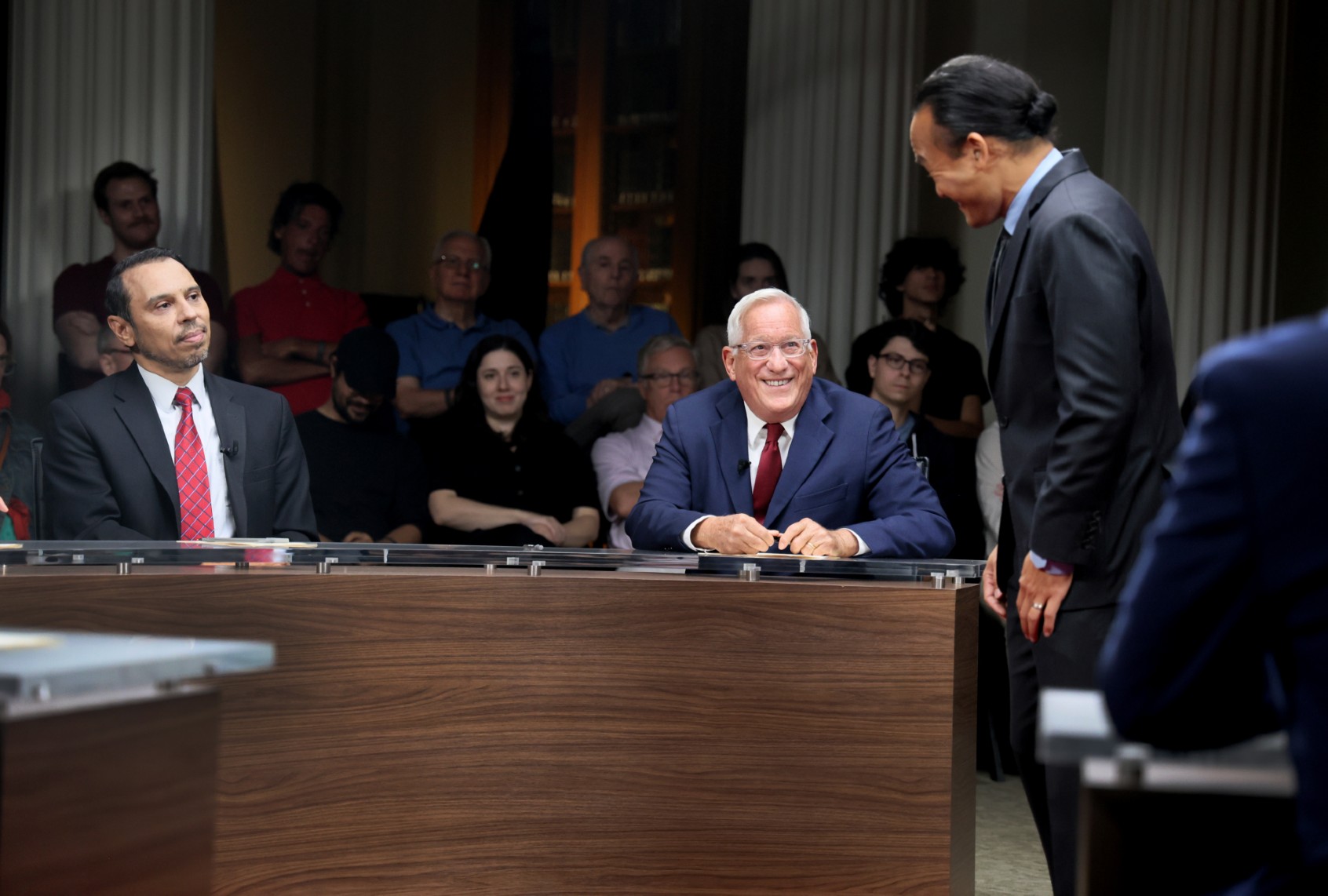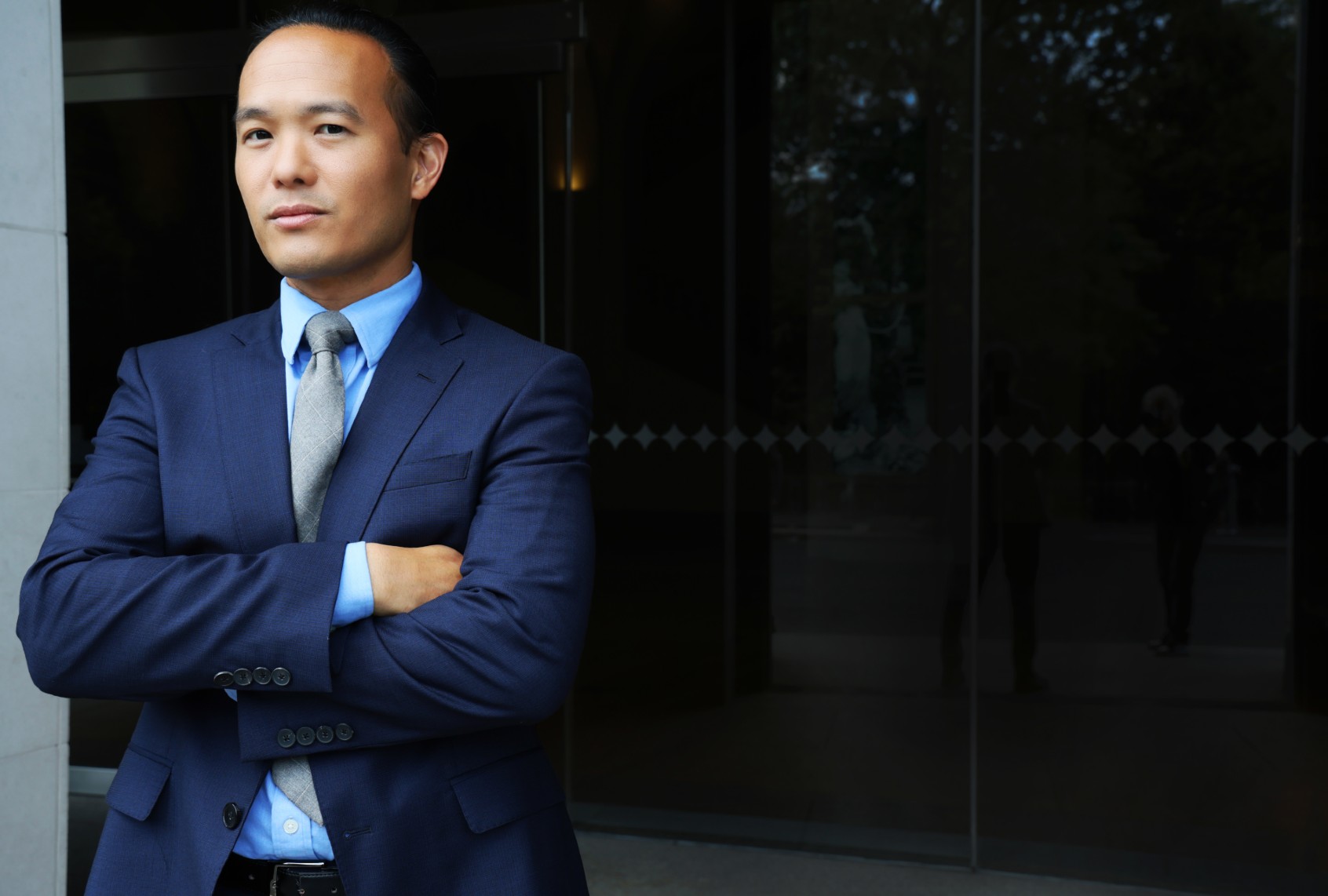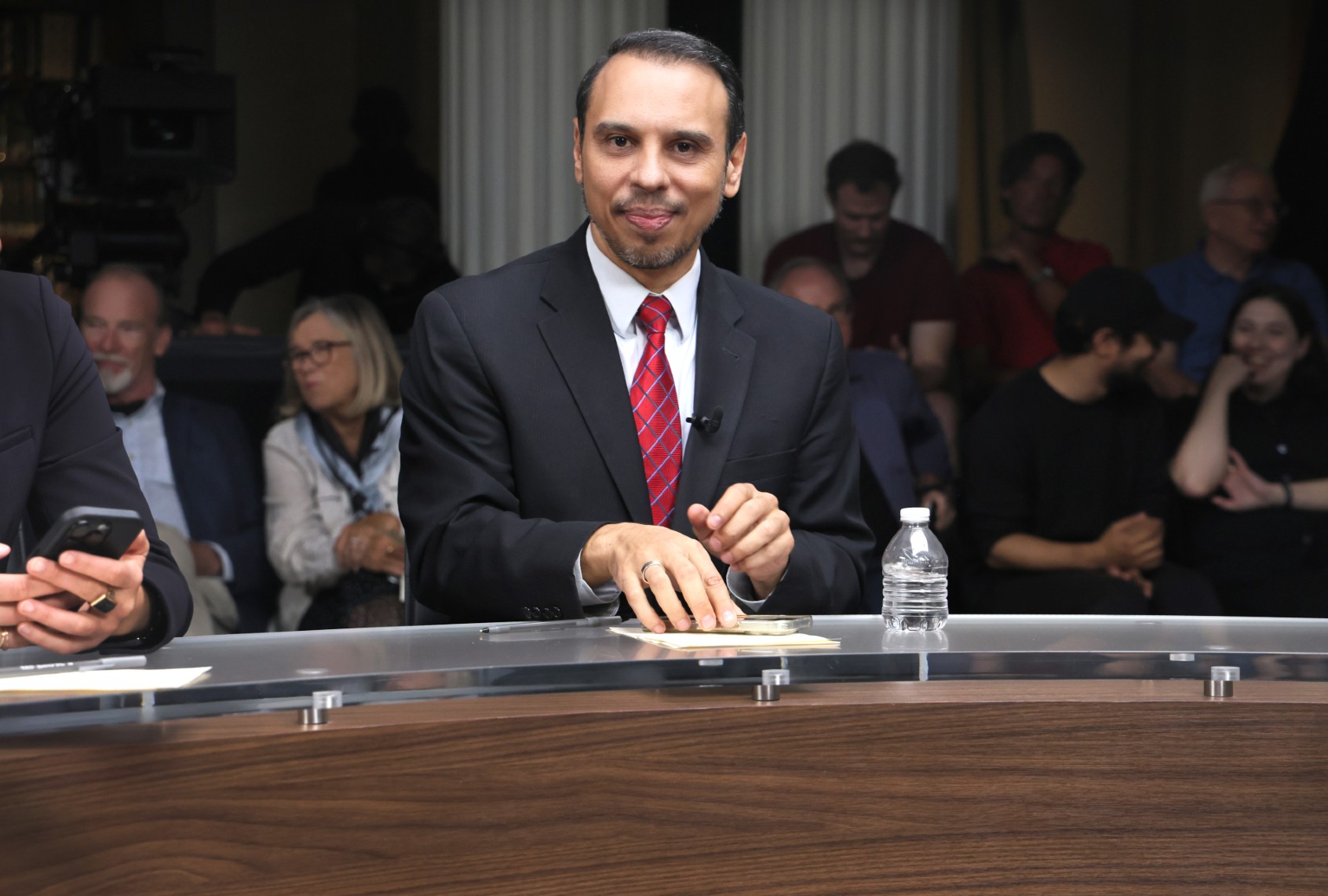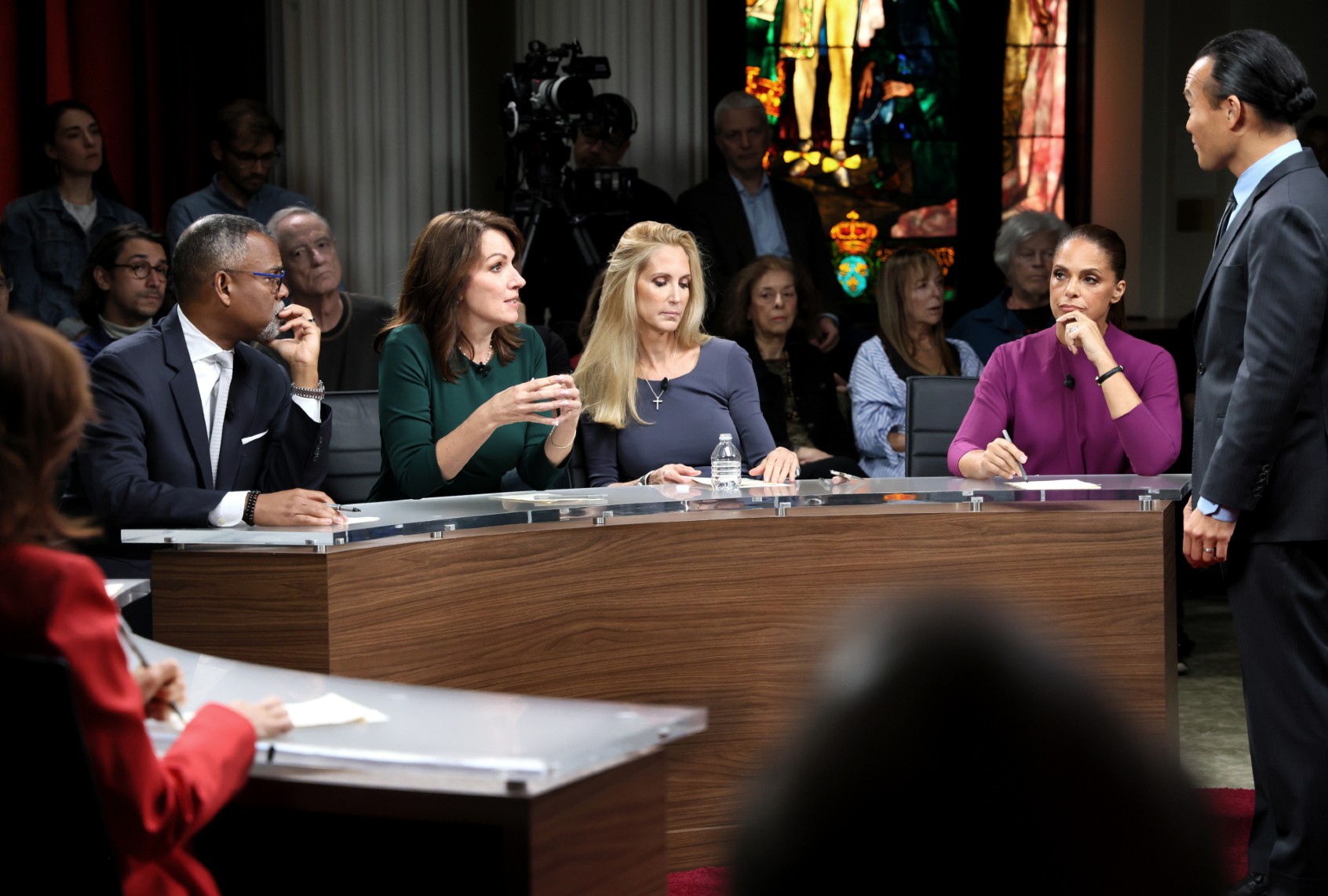“Breaking the Deadlock” shows us what civil discourse could look like
Eddie Glaude Jr. slumps a bit as he rubs his forehead, the universal sign of being overwhelmed by the flood of partisan nonsense Aaron Tang fictionalizes in “Breaking the Deadlock: Truth Under Fire.” In the real world, Tang teaches law at the University of California, Davis, while Glaude is a professor of African American Studies at Princeton.
But in this program, Tang serves as both moderator and storyteller, spinning a theoretical scenario that casts Glaude as a high school civics teacher in Libertyville, Middlevania. Tang informs Glaude that the Libertyville School Board has decided that a copy of the Ten Commandments must be hung on the wall of every classroom, reflecting recent Republican-led efforts to advance similar mandates in more than a dozen states.
Tang asks the educator what he would do. Without hesitation, Glaude pantomimes placing his copy under his desk, explaining that he understands this could cost him his job, but he’s willing to pay that price to champion the separation of church and state.
Seated next to Glaude at this politically diverse roundtable is Moms for Liberty co-founder Tina Descovich, who spouts specious verbiage about the country’s supposed founding on Judeo-Christian values and sternly warns Glaude he’s probably going to be fired. Nearby, MSNBC host Stephanie Ruhle and Rick Wilson, co-founder of The Lincoln Project, are cast as a local TV journalist and the campaign manager, respectively, for Middlevania’s sitting governor, played by Joe Biden’s former senior adviser Mitch Landrieu.

(Cristina Tarantola) Roger Severino, Walter Isaacson and Aaron Tang in “Breaking the Deadlock”
Since this community tension sparks protests shortly before election day, each has a vested interest in standing up for Glaude’s rights. But the governor’s conservative opponent, played by The Heritage Foundation’s Roger Severino, is ready to throw Glaude under the bus for his own political gain. And then, predictably, an incendiary act kicks the story into overdrive: Footage of someone burning the Ten Commandments surfaces on social media.
By remaining a few steps removed from the “Debate me, bro” pit, Tang and the show’s executive producers, Andrew Lack and John Bredar, highlight for the audience the multiple forces shaping the stories that supposedly define America, from the press to lobbyists, from politicians to influencers.
Cable news, whose viewpoint is portrayed by journalist and producer Soledad O’Brien, swoops in to cover this latest culture war flare-up. So do Internet provocateurs, represented here by Ann Coulter, pretty much playing herself and proving that it isn’t an act. Tang steadily tosses in new details as the story unfolds, halting at every square on the sidewalk to ask relevant parties what they would do.
By the time Glaude resorts to massaging away what looks like a headache, a mythical political aide nicknamed Piña Colada Guy has shifted this game of “What If?” miles beyond a debate about interpretations of the First Amendment’s Establishment Clause. Now it’s a feeding frenzy involving a hidden camera stunt that Severino’s candidate and Coulter’s digital bomb thrower are happy to capitalize upon. Our attention then returns to the original flashpoint in a way that should, in some respects, exonerate Glaude’s teacher. But as he points out, this development arrives too late to dissuade all the invisible forces Glaude has been battling without support.
By remaining a few steps removed from the “Debate me, bro” pit, Tang and the show’s executive producers, Andrew Lack and John Bredar, highlight for the audience the multiple forces shaping the stories that supposedly define America, from the press to lobbyists, from politicians to influencers. O’Brien, a former CNN star and an executive producer of “The Perfect Neighbor,” is especially spirited and charismatic in her demonstration of cable news’ mercenary “If it bleeds, it leads” ethos, as Ruhle points out that a local news reporter would cover her community with more nuance.
Coulter, though, reaffirms that her wingnut perspective can’t be turned off regardless of the forum. That has its uses too.
The type of public affairs programming that “Breaking the Deadlock” is modeled on is largely a relic of the 1960s and ‘70s, when TV was still a relatively new medium and networks made an effort to inform and educate the public on a broad range of topics. The Federal Communications Commission’s abolishment of the Fairness Doctrine in 1987 marked the end of all that. The rise of partisan opinion on cable, combined with the demise of civics education and the Internet’s misinformation surge, constructed a sludge factory on that policy’s sun-bleached bones.

(Cristina Tarantola) “Breaking the Deadlock” host Aaron Tang
Before that seismic turn transformed our definition of news and our trust in its brokers, former CBS News president Fred Friendly created a 10-part series called “Ethics in America” that aired between 1988 and 1989. The title itself hints at what a different time that was for TV and our nation: Thought leaders, academics and politicians gathered for this thought experiment in good faith. PBS’ politics obsessives were rapt.
Its panelists weren’t small figures in their fields, either. Supreme Court Justice Antonin Scalia, Warren Buffett, former U.S. Surgeon General C. Everett Coop, Vice Presidential candidate Geraldine Ferraro, former New York congressman Barney Frank, and journalists Mike Wallace, Peter Jennings, Anna Marie Quindlen, along with former Washington Post publisher Katharine Graham, participated at some point during its run. So did Rudy Giuliani and Newt Gingrich.
The public has strong feelings about most of these people; in many cases, those thoughts wouldn’t qualify as charitable. But that was the goal of “Ethics in America” — to gather people with fierce viewpoints, some of whom might view others in their midst as enemies outside of the production’s neutral bubble, to play with and sometimes burst preconceived notions about their neighbors.
Start your day with essential news from Salon.
Sign up for our free morning newsletter, Crash Course.
“Breaking the Deadlock” arrives in an era defined by misinformation and the inability to agree on a shared reality based on proven fact. Descovich mentions a version of this, but in doing so conflates the word “truth” with “fact.” The terms have different meanings, one subjective, the other objective.
But then, people familiar with the damage Moms for Liberty has wrought upon public schools and libraries across the country may wince at seeing Descovich seated beside a professor whose curriculum probably contains material her surrogates would delight in censoring.
Her presence, and that of Trump flunky and CNN contributor Scott Jennings in a previous “Deadlock” episode, disprove the MAGA claim that the right isn’t represented on public television programming. Obviously it is, and it’s equally obvious that those critics don’t watch PBS. Attacking the service in bad faith scores more political points.
“Breaking the Deadlock” arrives in an era defined by misinformation and the inability to agree on a shared reality based on proven fact.
This show isn’t going to change that, although persuasion isn’t its purpose. “Breaking the Deadlock” exists as a model of what a sensible exchange of views should look like while depicting how partisan biases are distorting our discourse.
“Truth Under Fire” was filmed 11 days after Charlie Kirk was fatally shot on the campus of Utah Valley University, the first stop on a tour of college campuses where he planned to “debate” audience members. I place that term in quotation marks since, as many people have said and continue to say, the version of “debate” that Kirk popularized is a wrestling match in a mud pit of logical fallacies.
This series doesn’t employ a classic debate format either, to be clear. It is more of a political and cultural wargame set within the safer realm of the hypothetical. Each of the 10 panelists featured in this episode plays a role closely resembling who they are in the real world. Their only instruction before filming is not to fight the scenario.
Hence, the lack of fact-checking can be irritating for viewers to witness. That irks the panelists, too, evidenced in a shot of Wilson rolling his eyes at one of Coulter’s kookier mendacities. But Tang’s goal is to show the audience and panelists how easily our actions can be twisted when passion overtakes reason.
Famed biographer Walter Isaacson sits at the “Truth Under Fire” table, too. There comes a moment when Tang asks him whose job it is to tell the truth to voters. By that point, Descovich has expressed regret about possibly misjudging Glaude’s civics teacher, and one candidate in this fantasy gubernatorial race knowingly has capitalized on a manufactured scandal.
“The truth is always going to come out, and so the job is to tell the truth,” Isaacson answers, adding, “You’re going to get a lot of blowback when the truth comes out and you’re the one who either bore false witness or didn’t help get the truth out.”
Severino tells Isaacson that his observation affected him. “You want to win, right?” he said. “You don’t want to win with ever compromising anything of your integrity.” He adds that Isaacson made him consider the long view of a biographer looking back on a person’s life and what his children would think of what he, in character, had done. Certain victories aren’t worth that compromise, Severino concludes.

(Cristina Tarantola) Roger Severino in “Breaking the Deadlock”
Realists may notice that the people gathered to play this game are also skilled at appearing reasonable when the cameras are rolling. Severino, a co-author of Project 2025, envisioned remaking the Department of Health and Human Services into an agency dedicated to dismantling reproductive rights, including outlawing mifepristone, an essential abortion medication. One guess is that such suggestions are his version of acting with integrity.
This circles back to the original premise of Friendly’s original TV seminars and “Breaking the Deadlock,” asking us to think about what we owe our neighbors and communities. These episodes don’t necessarily end with participants finding common ground in a kumbaya moment. They likely shook hands as they left the New York Historical, where the episode was filmed, content to have participated in a demonstration that relative comity is possible . . . in Middlevania. America in 2025 remains mired in all sorts of ideological stalemates. Our conversations on how to get past them and the headaches they produce continue.
“Breaking the Deadlock” episodes are streaming on PBS.org, YouTube and the PBS app.
Read more
about this topic


